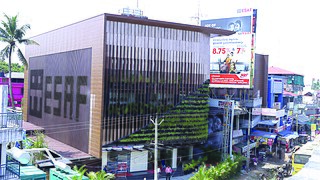Related Research Articles

Microfinance is a category of financial services targeting individuals and small businesses who lack access to conventional banking and related services. Microfinance includes microcredit, the provision of small loans to poor clients; savings and checking accounts; microinsurance; and payment systems, among other services. Microfinance services are designed to reach excluded customers, usually poorer population segments, possibly socially marginalized, or geographically more isolated, and to help them become self-sufficient. ID Ghana is an example of a microfinance institution.

Cooperative banking is retail and commercial banking organized on a cooperative basis. Cooperative banking institutions take deposits and lend money in most parts of the world.

Small Industries Development Bank of India (SIDBI) is the apex regulatory body for overall licensing and regulation of micro, small and medium enterprise finance companies in India. It is under the jurisdiction of Ministry of Finance, Government of India headquartered at Lucknow and having its offices all over the country.The SIDBI was established on April 2, 1990, by Government of India, as a wholly owned subsidiary of IDBI Bank. It was delinked from IDBI w.e.f. March 27, 2000. Its purpose is to provide refinance facilities to banks and financial institutions and engage in term lending and working capital finance to industries, and serves as the principal financial institution in the Micro, Small and Medium Enterprises (MSME) sector. SIDBI also coordinates the functions of institutions engaged in similar activities. It was established in 1990, through an Act of Parliament.

Flow of funds accounts are a system of interrelated balance sheets for a nation, calculated periodically. There are two types of balance sheets: those showing
Village banking is a microcredit methodology whereby financial services are administered locally rather than centralized in a formal bank. Village banking has its roots in ancient cultures and was most recently adopted for use by micro-finance institutions (MFIs) as a way to control costs. Early MFI village banking methods were innovated by Grameen Bank and then later developed by groups such as FINCA International founder John Hatch. Among US-based non-profit agencies there are at least 31 microfinance institutions (MFIs) that have collectively created over 800 village banking programs in at least 90 countries. And in many of these countries there are host-country MFIs—sometimes dozens—that are village banking practitioners as well.

BASIX is an institution concerning the promotion of livelihood established in 1996 in India. It is headquartered in Hyderabad, Telangana.
Bharat Financial Inclusion Limited or BFIL is a banking & finance company (NBFC), licensed by the Reserve Bank of India. It was founded in 1997 by Vikram Akula, who served as its executive chair until working. The company's mission is to provide financial services to the poor under the premise that providing financial service to poor borrowers helps to alleviate poverty. In 2011, the company operated across 11 Indian states.
A non-banking financial institution (NBFI) or non-bank financial company (NBFC) is a financial institution that is not legally a bank; it does not have a full banking license or is not supervised by a national or international banking regulatory agency. NBFC facilitate bank-related financial services, such as investment, risk pooling, contractual savings, and market brokering. Examples of these include hedge funds, insurance firms, pawn shops, cashier's check issuers, check cashing locations, payday lending, currency exchanges, and microloan organizations. Alan Greenspan has identified the role of NBFIs in strengthening an economy, as they provide "multiple alternatives to transform an economy's savings into capital investment which act as backup facilities should the primary form of intermediation fail."
Financial inclusion is the availability and equality of opportunities to access financial services. It refers to a process by which individuals and businesses can access appropriate, affordable, and timely financial products and services which include banking, loan, equity, and insurance products. It is a path to enhance inclusiveness in economic growth by enabling the unbanked population to access the means for savings, investment, and insurance towards improving household income and reducing income inequality
The Muthoot Group is an Indian multinational conglomerate headquartered in Kochi, Kerala. It has interests in financial services, information technology, media, healthcare, education, power generation, infrastructure, plantations, precious metal, restaurant, and hospitality. Muthoot Group operates in 29 states in India, and has presence in Nepal, Sri Lanka, US, UK and UAE. The group manages assets of over $4.5 billion. It is owned and managed by the Muthoot family.
External commercial borrowing (ECBs) are loans in India made by non-resident lenders in foreign currency to Indian borrowers. They are used widely in India to facilitate access to foreign money by Indian corporations and PSUs. ECBs include commercial bank loans, buyers' credit, suppliers' credit, securitised instruments such as floating rate notes and fixed rate bonds etc., credit from official export credit agencies and commercial borrowings from the private sector window of multilateral financial Institutions such as International Finance Corporation (Washington), ADB, AFIC, CDC, etc. ECBs cannot be used for investment in stock market or speculation in real estate. The DEA, Ministry of Finance, Government of India along with Reserve Bank of India, monitors and regulates ECB guidelines and policies.
Hattha Kaksekar Limited or HKL is a microfinance institution and a deposit-taking institution in Cambodia. In terms of loan portfolio, HKL is ranked fourth and it has the third largest saving portfolio among Cambodia MFIs.
Bandhan Bank Ltd. is a banking and financial services company, headquartered in Kolkata. Bandhan Bank is present in 35 out of 36 states and union territories of India, with 6,250 banking outlets and 3.26 crore customers. Having received the universal banking licence from the Reserve Bank of India, Bandhan Bank started operations on August 23, 2015, with 501 branches, 50 ATMs and 2,022 Banking Units (BUs). The Bank has mobilised deposits of ₹1,17,422 crore and its total advances stand at ₹1,15,940 crore as of December 31, 2023.
Small finance banks (SFB) are a type of niche banks in India. Banks with a SFB license can provide basic banking service of acceptance of deposits and lending. The aim behind these is to provide financial inclusion to sections of the economy not being served by other banks, such as small business units, small and marginal farmers, micro and small industries and unorganised sector entities.
Bajaj Finance Limited (BFL) is an Indian non-banking financial company headquartered in Pune. It is one of the leading non-banking financial companies (NBFCs) of India with a customer base of 73 million and holds assets under management worth ₹270,050 crore (US$34 billion).

ESAF Small Finance Bank is an Indian small finance bank headquartered in Thrissur, Kerala, providing banking services and small loans to the underbanked. Having started its operations as an NGO in 1992 under the name of Evangelical Social Action Forum, ESAF Microfinance was a non-banking finance company and microfinance institution (NBFC-MFI), licensed by the Reserve Bank of India (RBI). It became a small finance bank in March 2017 and started operating in January 2018.
Samit Ghosh is the founder of Ujjivan Financial Services Limited, and served as its managing director and chief executive officer until 31 January 2017, when he accepted an equivalent role with subsidiary Ujjivan Small Finance Bank. Prior to 2004, he held positions at Citibank, Standard Chartered, and HDFC Bank. He served as CEO of Ujjivan Financial Services till 2017. Ghosh is currently the non-executive Chairman of Ujjivan Financial Services.
Satin Creditcare Network Limited is a non-banking finance company (NBFC), licensed by the Reserve Bank of India. It was founded in 1990 by Mr. H P Singh. The company's offers financial requirements for excluded households at the bottom of the pyramid. Satin Creditcare Network Limited is a micro-finance institution (MFI) in the country with presence in 7 states and more than 12,00 villages.

VFS Capital Limited formerly known as Village Financial Services Ltd (VFS), is headquartered in Kolkata, was incorporated on 28 June 1994, as a private limited company before it got its present name.
Financial regulation in India is governed by a number of regulatory bodies. Financial regulation is a form of regulation or supervision, which subjects financial institutions to certain requirements, restrictions and guidelines, aiming to maintain the stability and integrity of the financial system. This may be handled by either a government or non-government organization. Financial regulation has also influenced the structure of banking sectors by increasing the variety of financial products available. Financial regulation forms one of three legal categories which constitutes the content of financial law, the other two being market practices and case law.
References
- ↑ "NBFC".
- ↑ "Reserve Bank of India - Frequently Asked Questions".
- ↑ "A brief history of NBFC in India". 27 January 2020. Retrieved 25 November 2020.
- ↑ https://mpra.ub.uni-muenchen.de/64250/1/MPRA_paper_64250.pdf [ bare URL PDF ]
- 1 2 "Reserve Bank of India - Notifications". www.rbi.org.in. Retrieved 4 October 2019.
- ↑ Choudhury, Neha Alawadhi & Karan (27 July 2019). "Account aggregator to make applying for loan less cumbersome for users". Business Standard India. Retrieved 4 October 2019.
- ↑ "Account Aggregators in India". Sahamati. Retrieved 9 September 2020.
- ↑ Prime, E. T. "These five companies quietly got the RBI's new". The Economic Times. Retrieved 4 October 2019.
- ↑ "Reserve Bank of India - Notifications". www.rbi.org.in. Retrieved 1 February 2022.
- ↑ Agrawal, Swati (8 December 2021). "Reserve Bank of India announces tighter regulations for NBFCs in India". Majmudar & Partners. Retrieved 1 February 2022.
- ↑ "MFI".
- ↑ "Micro Financial Institutions | Microfinance and microcredit". Microfinance and microcredit. Retrieved 29 November 2015.
- ↑ "Homepage - MFIN". MFIN. Retrieved 29 November 2015.
- ↑ "MFIs go for NBFC licences for better access to funds". The Economic Times.
- ↑ "Reserve Bank of India - Notifications".
- ↑ "Reserve Bank of India - Notifications".
- ↑ "The 50 Top Microfinance Institutions". Forbes .
- ↑ "India in Forbes' list of leading microfinance institutes - Times of India". The Times of India . 26 December 2007.
- ↑ "Andhra Pradesh Government to introduce Bill to check rogue MFI's - MoneyMint". 20 December 2015.
- ↑ "Download Andhra Pradesh Microfinance Ordinance 2010 PDF - MoneyMint". 30 November 2022.
- ↑ "SKS skids amid Andhra Pradesh crackdown on lenders to poor". Reuters. 18 November 2010.